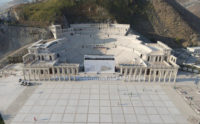Serving up to 80 students, this 6,000-sq-ft early childhood development center and teacher training facility in Johannesburg, South Africa, was the culmination of two years of planning, design and construction led by student volunteers from Cornell University. Opened in 2011, the schoolhouse has become an integral part of the neighborhood and showcases the use of innovative building systems in low-income communities.
 |
Cornell University Sustainable Design (CUSD) was formed by students involved with the Solar Decathlon competition to "rethink how we can continue a design-build program but broaden our horizons," says Barry Beagen, project director. The group's interest in social, ecological and economic sustainability led them to partner with Education Africa's Social Architecture program, which encourages student organizations to design and construct low-cost preschools within impoverished communities.
After visiting the project site and speaking with local educators and community leaders, CUSD organized the project's design development via a competition among Cornell architecture students. Goals such as passive energy and low maintenance were identified early on. Funding for the project, which normally would have cost more than $500,000, was covered by donations from suppliers, sponsor organizations and student volunteers from over 22 countries. CUSD promoted a shared ownership in the preschool and increased cross-cultural learning by encouraging foreign students to work side by side with members of the local community.
"It was very important to formulate a common vision, because everyone had a stake in it," Beagen says. "That common vision was the same with the suppliers, contractors and our partners as well, because we knew this project wasn't just about the volunteers coming and going."
The building's structure was formed using earth-filled polypropylene bags placed inside EcoBeam frames. The extremely low-cost system increased the building's thermal mass and eliminated the need for active heating or cooling systems. "By filling the bags with soil excavated during the foundation-laying process, we reduced waste and transportation while transforming residual matter into a high-performing and resilient wall system," says CUSD member Daniel Lu. A reinforced concrete ring beam was placed atop columns integrated into the wall system to increase interior spans and prolong the building's useful life. Clerestory windows and child-height portal windows eliminate the need for electric lighting.
During the three-month build, CUSD required on-site volunteers to conform to U.S. and South African safety standards. As a result, the project's 23,000 man hours resulted in no injuries, which "speaks volumes for the volunteer workers," said a judge.
While the students learned many new skills, Beagen says the most important lesson for him was found in building character and leadership. "To me, managing relationships among the students and among the different contractors was the most valuable experience."
Location Johannesburg
Project Team
Owner Basil Read Developments, Johannesburg
Architect Cornell University Sustainable Design, Ithaca, N.Y.
General Contractor PD Solutions, Johannesburg
Engineers Tetra Tech, Ithaca; PD Solutions, Johannesburg
Partner Organizations Education Africa, Johannesburg; City of Johannesburg; Play-With-A-Purpose, Muldersdrift, South Africa









Post a comment to this article
Report Abusive Comment